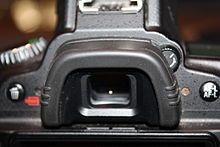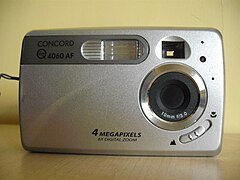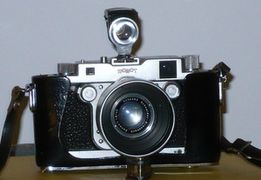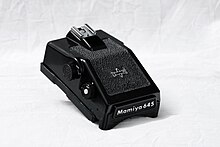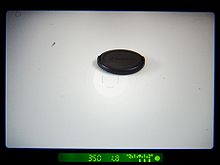
A single-lens reflex camera (SLR) is a camera that typically uses a mirror and prism system that permits the photographer to view through the lens and see exactly what will be captured. With twin lens reflex and rangefinder cameras, the viewed image could be significantly different from the final image. When the shutter button is pressed on most SLRs, the mirror flips out of the light path, allowing light to pass through to the light receptor and the image to be captured.

A camera is an optical instrument used to capture and store images and videos, either digitally via an electronic image sensor, or chemically via a light-sensitive material such as photographic film. As a pivotal technology in the fields of photography and videography, cameras have played a significant role in the progression of visual arts, media, entertainment, surveillance, and scientific research. The invention of the camera dates back to the 19th century and has since evolved with advancements in technology, leading to a vast array of types and models in the 21st century.

A rangefinder camera is a camera fitted with a rangefinder, typically a split-image rangefinder: a range-finding focusing mechanism allowing the photographer to measure the subject distance and take photographs that are in sharp focus. Most varieties of rangefinder show two images of the same subject, one of which moves when a calibrated wheel is turned; when the two images coincide and fuse into one, the distance can be read off the wheel. Older, non-coupled rangefinder cameras display the focusing distance and require the photographer to transfer the value to the lens focus ring; cameras without built-in rangefinders could have an external rangefinder fitted into the accessory shoe. Earlier cameras of this type had separate viewfinder and rangefinder windows; later the rangefinder was incorporated into the viewfinder. More modern designs have rangefinders coupled to the focusing mechanism so that the lens is focused correctly when the rangefinder images fuse; compare with the focusing screen in non-autofocus SLRs.

A twin-lens reflex camera (TLR) is a type of camera with two objective lenses of the same focal length. One of the lenses is the photographic objective or "taking lens", while the other is used for the viewfinder system, which is usually viewed from above at waist level.
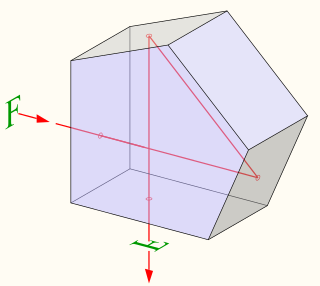
A pentaprism is a five-sided reflecting prism used to deviate a beam of light by a constant 90°, even if the entry beam is not at 90° to the prism. The beam reflects inside the prism twice, allowing the transmission of an image through a right angle without inverting it as an ordinary right-angle prism or mirror would.
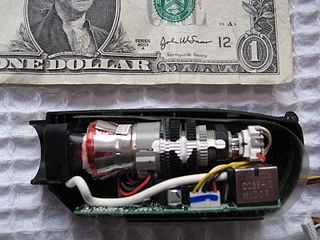
An electronic viewfinder (EVF) is a camera viewfinder where the image captured by the lens is displayed on a small screen which the photographer can look through when composing their shot. It differs from a live preview screen in being smaller and shaded from ambient light, and may also use less power. The sensor records the view through the lens, the view is processed, and finally projected on a miniature display which is viewable through the eyepiece.

A point-and-shoot camera, also known as a compact camera and sometimes abbreviated to P&S, is a still camera designed primarily for simple operation. Most use focus free lenses or autofocus for focusing, automatic systems for setting the exposure options, and have flash units built in. They are popular for vernacular photography by people who do not consider themselves photographers but want easy-to-use cameras for snapshots of vacations, parties, reunions and other events.

A digital single-lens reflex camera is a digital camera that combines the optics and the mechanisms of a single-lens reflex camera with a solid-state image sensor and digitally records the images from the sensor.
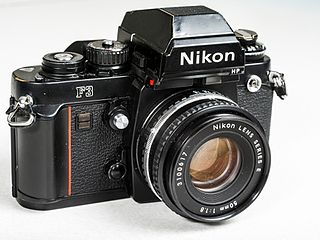
The Nikon F3 was Nikon's third professional single-lens reflex camera body, preceded by the F and F2. Introduced in March 1980, it had manual and semi-automatic exposure control whereby the camera would select the correct shutter speed. The Nikon F3 series cameras had the most model variations of any Nikon F camera. It was also the first of numerous Nikon F-series cameras to be styled by Italian designer Giorgetto Giugiaro, and to include a red stripe on the handgrip – a feature that would later become a signature feature of many Nikon cameras.
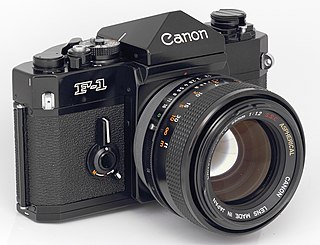
The Canon F-1 is a 35 mm single-lens reflex camera produced by Canon of Japan from March 1971 until the end of 1981, at which point it had been superseded by the New F-1 launched earlier that year. The Canon FD lens mount was introduced along with the F-1, but the previous Canon FL-mount lenses and older R- series lenses were also compatible with the camera with some limitations. The Canon F-1 was marketed as a competitor to the Nikon F and Nikon F2 single lens reflex cameras by Nikon.
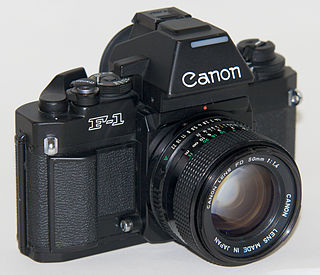
The Canon New F-1 replaced the F-1n as Canon's top-of-the-line 35mm single-lens reflex camera in September 1981. Like the earlier models, the New F-1 takes FD-mount lenses. Although no date has ever been confirmed, it is thought that the last New F-1 was made in 1992. It was officially discontinued in 1994, and factory support ended in 2004.
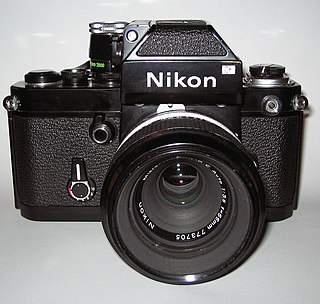
The Nikon F2 is a professional-level, interchangeable lens, 35 mm film, single-lens reflex (SLR) camera. It was manufactured by the Japanese optics company Nippon Kogaku K. K. in Japan from September 1971 to 1980. It used a horizontal-travel focal plane shutter with titanium shutter curtains and a speed range of 1 to 1/2000 second plus Bulb and Time, and flash X-sync of 1/80 second. It had dimensions of 98 mm height, 152.5 mm width, 65 mm depth and 730 g weight. It was available in two colors: black with chrome trim and all black. The F2 was adopted by both casual photographers and professional photographers, the latter of those especially photojournalists covering the later half of the Vietnam War.

The history of the single-lens reflex camera (SLR) begins with the use of a reflex mirror in a camera obscura described in 1676, but it took a long time for the design to succeed for photographic cameras. The first patent was granted in 1861, and the first cameras were produced in 1884, but while elegantly simple in concept, they were very complex in practice. One by one these complexities were overcome as optical and mechanical technology advanced, and in the 1960s the SLR camera became the preferred design for many high-end camera formats.
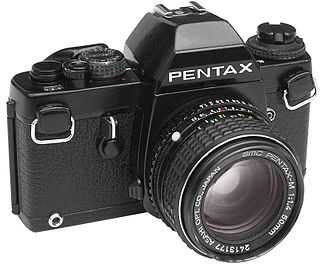
The Pentax LX is a 35mm single-lens reflex camera produced by Pentax in Japan. It was introduced in 1980 to commemorate the 60th anniversary of Asahi Optical Co., and was produced until 2001. It is the top-of-the-line professional, or "system", camera in the Pentax manual focus range, with manual and aperture priority automatic exposure modes and an advanced light metering system. The LX uses the K mount, which is the Pentax proprietary bayonet lens mount, and has a large body of accessories. The camera has several unique or uncommon features, and compared with contemporary professional camera bodies from rival manufacturers, like the Canon New F-1 or Nikon F3, the LX body is smaller and lighter, weighing in at 570 grams with its standard FA-1 finder.
A reflex finder is a viewfinder system with a mirror placed behind a lens. The light passing through the lens is reflected by the mirror to a focusing screen, usually ground glass. The image formed on this ground glass can be observed directly, giving a waist-level reflex finder, or through a redressing optical device for eye-level viewing, giving an eye-level reflex finder.

Live preview is a feature that allows a digital camera's display screen to be used as a viewfinder. This provides a means of previewing framing and other exposure before taking the photograph. In most such cameras, the preview is generated by means of continuously and directly projecting the image formed by the lens onto the main image sensor. This in turn feeds the electronic screen with the live preview image. The electronic screen can be either a liquid crystal display (LCD) or an electronic viewfinder (EVF).

The waist-level finder (WLF), also called waist-level viewfinder (WLVF), is a type of viewfinder that can be used on twin lens and single lens reflex cameras. While it is typically found on older medium format cameras, some newer and/or 35 mm cameras have this type of finder.

A pellicle mirror is an ultra-thin, ultra-lightweight semi-transparent mirror employed in the light path of an optical instrument, splitting the light beam into two separate beams, both of reduced light intensity. Splitting the beam allows its use for multiple purposes simultaneously. The thinness of the mirror practically eliminates beam or image doubling due to a non-coincident weak second reflection from the nominally non-reflecting surface, a problem with mirror-type beam splitters. The name pellicle is a diminutive of pellis, a skin or film.
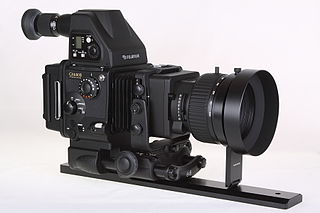
The Fuji GX680 is a series of single lens reflex system cameras for medium format film produced by Fujifilm with interchangeable camera lenses and interchangeable film holders for the unusual film format 6×8 cm on 120 and 220 roll film. The distinguishing feature of the Fuji GX680 is the articulating front standard, which runs on a rail connecting lens and camera body by a bellows; the interchangeable lens is permanently mounted to a lens board.
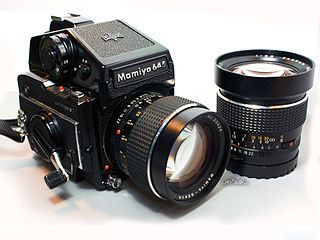
The Mamiya 645 camera systems are a series of medium format film and digital cameras and lenses manufactured by Mamiya and its successors. They are called "645" because they use the nominal 6 cm x 4.5 cm film size from 120 roll film. They came in three major generations: first-generation manual-focus film cameras, second-generation manual-focus film cameras, and autofocus film/digital cameras.
